Two big explanations - geopolitics and the world economy (Peak Oil). Are they mutually exclusive?
WTI
Hits $52 Handle As US Rig Count Tumbles To 8-Month Lows
29
December, 2014
Just
as T.
Boone Pickens warned "watch the rig counts" last week,
so the Baker Hughes rig countjust collapsed for the 3rd week in a row
to 8-month lows. This is the fastest 3-week drop since mid-2009.
Crude prices were already weak but the news has flushed WTI to a $52
handle (not seen in the front-month contract since May 2009)
Rig
count is tumbling...
Some
context for the surge in US rig count...
And
while the drop in Canadian rig count sounds impressive - it's the
worst since 2009 - it's much more seasonal
WTI
Hits A $52 handle!!
And
then there's this...
Charts:
bloomberg
"NATO
and the United States should change their policy because the time
when they dictate their conditions to the world has passed,"
Ahmadinejad said in a speech in Dushanbe, capital of the Central
Asian republic of Tajikistan
Did
the U.S. and the Saudis Conspire to Push Down Oil Prices?
Irreversible
Decline?
29
December, 2014
by
MIKE WHITNEY
“Saudi oil policy… has been subject to a great deal of wild and inaccurate conjecture in recent weeks. We do not seek to politicize oil… For us it’s a question of supply and demand, it’s purely business.”
– Ali al Naimi, Saudi Oil Minister
“There is no conspiracy, there is no targeting of anyone. This is a market and it goes up and down.”
– Suhail Bin Mohammed al-Mazroui, United Arab Emirates’ petroleum minister
“We all see the lowering of oil prices. There’s lots of talk about what’s causing it. Could it be an agreement between the U.S. and Saudi Arabia to punish Iran and affect the economies of Russia and Venezuela? It could.”
– Russian President Vladimir Putin
Are
falling oil prices part of a US-Saudi plan to inflict economic damage
on Russia, Iran and Venezuela?
Venezuelan
President Nicolas Maduro seems to think so. In a recent interview
that appeared in Reuters, Maduro said he thought the United States
and Saudi Arabia wanted to drive down oil prices “to harm Russia.”
Bolivian
President Evo Morales agrees with Maduro and told journalists at RT
that: “The reduction in oil prices was provoked by the US as an
attack on the economies of Venezuela and Russia. In the face of such
economic and political attacks, the nations must be united.”
Iranian
President Hassan Rouhani said the same thing,with a slightly
different twist: “The main reason for (the oil price plunge) is a
political conspiracy by certain countries against the interests of
the region and the Islamic world … Iran and people of the
region will not forget such … treachery against the interests of
the Muslim world.”
US-Saudi
“treachery”? Is that what’s really driving down oil prices?
Not
according to Saudi Arabia’s Petroleum Minister Ali al-Naimi.
Al-Naimi has repeatedly denied claims that the kingdom is involved in
a conspiracy. He says the tumbling prices are the result of “A lack
of cooperation by non-OPEC production nations, along with the spread
of misinformation and speculator’s greed.” In other words,
everyone else is to blame except the country that has historically
kept prices high by controlling output. That’s a bit of a stretch,
don’t you think? Especially since–according to the Financial
Times — OPEC’s de facto leader has abandoned the cartel’s
“traditional strategy” and announced that it won’t cut
production even if prices drop to $20 per barrel.
Why?
Why would the Saudis suddenly abandon a strategy that allowed them to
rake in twice as much dough as they are today? Don’t they like
money anymore?
And
why would al-Naimi be so eager to crash prices, send Middle East
stock markets into freefall, increase the kingdom’s budget deficits
to a record-high 5 percent of GDP, and create widespread financial
instability? Is grabbing “market share” really that important or
is there something else going on here below the surface?
The
Guardian’s Larry Elliot thinks the US and Saudi Arabia are engaged
a conspiracy to push down oil prices. He points to a September
meeting between John Kerry and Saudi King Abdullah where a deal was
made to boost production in order to hurt Iran and Russia. Here’s a
clip from the article titled “Stakes are high as US plays the oil
card against Iran and Russia”:
“…with the help of its Saudi ally, Washington is trying to drive down the oil price by flooding an already weak market with crude. As the Russians and the Iranians are heavily dependent on oil exports, the assumption is that they will become easier to deal with…
John Kerry, the US secretary of state, allegedly struck a deal with King Abdullah in September under which the Saudis would sell crude at below the prevailing market price. That would help explain why the price has been falling at a time when, given the turmoil in Iraq and Syria caused by Islamic State, it would normally have been rising.
The Saudis did something similar in the mid-1980s. Then, the geopolitical motivation for a move that sent the oil price to below $10 a barrel was to destabilize Saddam Hussein’s regime. This time, according to Middle East specialists, the Saudis want to put pressure on Iran and to force Moscow to weaken its support for the Assad regime in Syria… (Stakes are high as US plays the oil card against Iran and Russia, Guardian)
That’s
the gist of Elliot’s theory, but is he right?
Vladimir
Putin isn’t so sure. Unlike Morales, Maduro and Rouhani, the
Russian president has been reluctant to blame falling prices on
US-Saudi collusion. In an article in Itar-Tass, Putin opined:
“There’s a lot of talk around” in what concerns the causes for the slide of oil prices, he said at a major annual news conference. “Some people say there is conspiracy between Saudi Arabia and the US in order to punish Iran or to depress the Russian economy or to exert impact on Venezuela.”
“It might be really so or might be different, or there might be the struggle of traditional producers of crude oil and shale oil,” Putin said. “Given the current situation on the market the production of shale oil and gas has practically reached the level of zero operating costs.” (Putin says oil market price conspiracy between Saudi Arabia and US not ruled out, Itar-Tass)
As
always, Putin takes the most moderate position, that is, that
Washington and the Saudis may be in cahoots, but that droopy prices
might simply be a sign of over-supply and weakening demand. In other
words, there could be a plot, but then again, maybe not. Putin is a
man who avoids passing judgment without sufficient evidence.
The
same can’t be said of the Washington Post. In a recent article, WP
journalist Chris Mooney dismisses anyone who thinks oil prices are
the result of US-Saudi collaboration as “kooky conspiracy
theorists”. According to Mooney:
“The reasons for the sudden (price) swing are not particularly glamorous: They involve factors like supply and demand, oil companies having invested heavily in exploration several years ago to produce a glut of oil that has now hit the market — and then, perhaps, the “lack of cohesion” among the diverse members of OPEC.” (Why there are so many kooky conspiracy theories about oil, Washington Post)
Oddly
enough, Mooney disproves his own theory a few paragraphs later in the
same piece when he says:
“Oil producers really do coordinate. And then, there’s OPEC, which is widely referred to in the press as a “cartel,” and which states up front that its mission is to “coordinate and unify the petroleum policies” of its 12 member countries…. Again, there’s that veneer of plausibility to the idea of some grand oil related strategy.” (WP)
Let
me get this straight: One the one hand Mooney agrees that OPEC is a
cartel that “coordinates and unify the petroleum policies”, then
on the other, he says that market fundamentals are at work. Can you
see the disconnect? Cartels obstruct normal supply-demand dynamics by
fixing prices, which Mooney seems to breezily ignore.
Also,
he scoffs at the idea of “some grand oil related strategy” as if
these cartel nations were philanthropic organizations operating in
the service of humanity. Right. Someone needs to clue Mooney in on
the fact that OPEC is not the Peace Corps. They are monopolizing
amalgam of cutthroat extortionists whose only interest is maximizing
profits while increasing their own political power. Surely, we can
all agree on that fact.
What’s
really wrong with Mooney’s article, is that he misses the point
entirely. The debate is NOT between so-called “conspiracy
theorists” and those who think market forces alone explain the
falling prices. It’s between the people who think that the Saudis
decision to flood the market is driven by politics rather than a
desire to grab “market share.” That’s where people disagree. No
denies that there’s manipulation; they merely disagree about the
motive. This glaring fact seems to escape Mooney who is on a mission
to discredit conspiracy theorists at all cost. Here’s more:
(There’s) “a long tradition of conspiracy theorists who have surmised that the world’s great oil powers — whether countries or mega-corporations — are secretly pulling strings to shape world events.”…
“A lot of conspiracy theories take as their premise that there’s a small group of people who are plotting to control something, to control the government, the banking system, or the main energy source, and they are doing this to the disadvantage of everybody else,” says University of California-Davis historian Kathy Olmsted, author of “Real Enemies: Conspiracy Theories and American Democracy, World War I to 9/11″. (Washington Post)
Got
that? Now find me one person who doesn’t think the world is run by
a small group of rich, powerful people who operate in their own best
interests? Here’s more from the same article:
(Oil) “It’s the perfect lever for shifting world events. If you were a mad secret society with world-dominating aspirations and lots of power, how would you tweak the world to create cascading outcomes that could topple governments and enrich some at the expense of others? It’s hard to see a better lever than the price of oil, given its integral role in the world economy.” (WP)
“A
mad secret society”? Has Mooney noticed that — in the last decade
and a half — the US has only invaded nations that have huge natural
resources (mainly oil and natural gas) or the geography for critical
pipeline routes? There’s nothing particularly secret about it, is
there?
The
United States is not a “mad secret society with world-dominating
aspirations”. It’s a empire with blatantly obvious
“world-dominating aspirations” run by political puppets who do
the work of wealthy elites and corporations. Any sentient being who’s
bright enough to browse the daily headlines can figure that one out.
Mooney’s
grand finale:
“So in sum, with a surprising and dramatic event like this year’s oil price decline, it would be shocking if it did not generate conspiracy theories. Humans believe them all too easily. And they’re a lot more colorful than a more technical (and accurate) story about supply and demand.” (WP)
Ah,
yes. Now I see. Those darn “humans”. They’re so weak-minded
they’ll believe anything you tell them, which is why they need
someone as smart as Mooney tell them how the world really work.
Have
you ever read such nonsense in your life? On top of that, he gets the
whole story wrong. This isn’t about market fundamentals. It’s
about manipulation. Are the Saudis manipulating supply to grab market
share or for political reasons? THAT’S THE QUESTION. The fact that
they ARE manipulating supply is not challenged by anyone including
the uber-conservative Financial Times that deliberately pointed out
that the Saudis had abandoned their traditional role of cutting
supply to support prices. That’s what a “swing state” does; it
manipulates supply keep prices higher than they would be if market
forces were allowed to operate unimpeded.
So
what is the motive driving the policy; that’s what we want to know?
Certainly
there’s a strong case to be made for market share. No one denies
that. If the Saudis keep prices at rock bottom for a prolonged period
of time, then a high percentage of the producers (that can’t
survive at prices below $70 per barrel) will default leaving OPEC
with greater market share and more control over pricing.
So
market share is certainly a factor. But is it the only factor?
Is
it so far fetched to think that the United States–which in the last
year has imposed harsh economic sanctions on Russia, made every
effort to sabotage the South Stream pipeline, and toppled the
government in Kiev so it could control the flow of Russian gas to
countries in the EU–would coerce the Saudis into flooding the
market with oil in order to decimate the Russian economy, savage the
ruble, and create favorable conditions for regime change in Moscow?
Is that so hard to believe?
Apparently
New York Times columnist Thomas Freidman doesn’t think so. Here’s
how he summed it up in a piece last month: “Is it just my
imagination or is there a global oil war underway pitting the United
States and Saudi Arabia on one side against Russia and Iran on the
other?”
It
sounds like Freidman has joined the conspiracy throng, doesn’t it?
And he’s not alone either. This is from Alex Lantier at the World
Socialist Web Site:
“While there are a host of global economic factors underlying the fall in oil prices, it is unquestionable that a major role in the commodity’s staggering plunge is Washington’s collaboration with OPEC and the Saudi monarchs in Riyadh to boost production and increase the glut on world oil markets.
As Obama traveled to Saudi Arabia after the outbreak of the Ukraine crisis last March, the Guardian wrote, “Angered by the Soviet invasion of Afghanistan in 1979, the Saudis turned on the oil taps, driving down the global price of crude until it reached $20 a barrel (in today’s prices) in the mid-1980s… [Today] the Saudis might be up for such a move—which would also boost global growth—in order to punish Putin over his support for the Assad regime in Syria. Has Washington floated this idea with Riyadh? It would be a surprise if it hasn’t.” (Alex Lantier,Imperialism and the ruble crisis, World Socialist Web Site)
And
here’s an intriguing clip from an article at Reuters that suggests
the Obama administration is behind the present Saudi policy:
“U.S.
Secretary of State John Kerry sidestepped the issue (of a US-Saudi
plot) after a trip to Saudi Arabia in September. Asked if past
discussions with Riyadh had touched on Russia’s need for oil above
$100 to balance its budget, he smiled and said: “They (Saudis) are
very, very well aware of their ability to have an impact on global
oil prices.” (Saudi
oil policy uncertainty unleashes the conspiracy theorists,
Reuters)
Wink, win.
Of
course, they’re in bed together. Saudi Arabia is a US client. It’s
not autonomous or sovereign in any meaningful way. It’s a US
protectorate, a satellite, a colony. They do what they’re told.
Period. True, the relationship is complex, but let’s not be
ridiculous. The Saudis are not calling the shots. The idea is absurd.
Do you really think that Washington would let Riyadh fiddle prices in
a way that destroyed critical US domestic energy industries, ravaged
the junk bond market, and generated widespread financial instability
without uttering a peep of protest on the matter?
Dream
on! If the US was unhappy with the Saudis, we’d all know about it
in short-order because it would be raining Daisy Cutters from the
Persian Gulf to the Red Sea, which is the way that Washington
normally expresses its displeasure on such matters. The fact that
Obama has not even alluded to the shocking plunge in prices just
proves that the policy coincides with Washington’s broader
geopolitical strategy.
And
let’s not forget that the Saudis have used oil as a political
weapon before, many times before. Indeed, wreaking havoc is nothing
new for our good buddies the Saudis. Check this out from Oil Price
website:
“In 1973, Egyptian President Anwar Sadat convinced Saudi King Faisal to cut production and raise prices, then to go as far as embargoing oil exports, all with the goal of punishing the United States for supporting Israel against the Arab states. It worked. The “oil price shock” quadrupled prices.
It happened again in 1986, when Saudi Arabia-led OPEC allowed prices to drop precipitously, and then in 1990, when the Saudis sent prices plummeting as a way of taking out Russia, which was seen as a threat to their oil supremacy. In 1998, they succeeded. When the oil price was halved from $25 to $12, Russia defaulted on its debt.
The Saudis and other OPEC members have, of course, used the oil price for the obverse effect, that is, suppressing production to keep prices artificially high and member states swimming in “petrodollars”. In 2008, oil peaked at $147 a barrel.” (Did The Saudis And The US Collude In Dropping Oil Prices?, Oil Price)
1973,
1986, 1990, 1998 and 2008.
So,
according to the author, the Saudis have manipulated oil prices at
least five times in the past to achieve their foreign policy
objectives. But, if that’s the case, then why does the media
ridicule people who think the Saudis might be engaged in a similar
strategy today?
Could
it be that the media is trying to shape public opinion on the issue
and, by doing so, actually contribute to the plunge in oil prices?
Bingo.
Alert readers have probably noticed that the oil story has been
splashed across the headlines for weeks even though the basic facts
have not changed in the least. It’s all a rehash of the same
tedious story reprinted over and over again.
But, why? Why does the
public need to have the same “Saudis refuse to cut production”
story driven into their consciousness day after day like they’re
part of some great collective brainwashing experiment? Could it be
that every time the message is repeated, oil sells off, and prices go
down? Is that it?
Precisely.
For example, last week a refinery was attacked in Libya which pushed
oil prices up almost immediately. Just hours later, however, another
“Saudis refuse to cut production” story conveniently popped up in
all the major US media which pushed prices in the direction the USG
wants them to go, er, I mean, back down again.
This
is how the media helps to reinforce government policy, by crafting a
message that helps to push down prices and, thus, hurt “evil”
Putin. (This is called “jawboning”) Keep in mind, that OPEC
doesn’t meet again until June, 2015, so there’s nothing new to
report on production levels. But that doesn’t mean we’re not
going to get regular updates on the “Saudis refuse to cut
production” story.
Oh, no. The media is going to keep beating that
drum until Putin cries “Uncle” and submits to US directives.
Either that, or the bond market is going to blow up and take the
whole damn global financial system along with it. One way or another,
something’s got to give.
Bottom
line: Falling oil prices and the plunging ruble are not some kind of
free market accident brought on by oversupply and weak demand. That’s
baloney.
They’re part of a broader geopolitical strategy to
strangle the Russian economy, topple Putin, and establish US hegemony
across the Asian landmass. It’s all part of Washington’s plan to
maintain its top-spot as the world’s only superpower even though
its economy is in irreversible decline.
MIKE
WHITNEY lives
in Washington state. He is a contributor to Hopeless:
Barack Obama and the Politics of Illusion (AK
Press). Hopeless is also available in a Kindle
edition. He
can be reached at fergiewhitney@msn.com.
Analyzing oil prices
How
increased inefficiency explains falling oil prices
Gail
Tverberg
29
December, 2014
Since
about 2001, several sectors of the economy have become increasingly
inefficient, in the sense that it takes more resources to produce a
given output, such as 1000 barrels of oil. I believe that this
growing inefficiency explains both slowing world economic growth and
the sharp recent drop in prices of many commodities, including oil.
The
mechanism at work is what I would call the crowding
out effect.
As more resources are required for the increasingly inefficient
sectors of the economy, fewer resources are available to the rest of
the economy. As a result, wages stagnate or decline. Central banks
find it necessary lower interest rates, to keep the economy going.
Unfortunately,
with stagnant or lower wages, consumers find that goods from the
increasingly inefficiently sectors are increasingly unaffordable,
especially if prices rise to cover the resource requirements of these
inefficient sectors. For most periods in the past, commodities
prices have stayed close to the cost of production (at least for the
“marginal producer”). What we seem to be seeing recently is a
drop in price to what
consumers can afford for
some of these increasingly unaffordable sectors. Unless this
situation can be turned around quickly, the whole system risks
collapse.
Increasingly
Inefficient Sectors of the Economy
We
can think of several increasingly inefficient sectors of the economy:
Oil. The
problem with oil is that much of the easy (and thus, cheap) to
extract oil is gone. There seems to be a great deal of
expensive-to-extract oil available. Some of it is deep under the sea,
even under salt layers. Some of it is very heavy and needs to be
“steamed” out. Some of it requires “fracking.” The extra
extraction steps require the use of more human labor and more
physical resources (oil and gas, metal pipes, fresh water), but
output rises by very little. Liquid extenders to oil, such as
biofuels and coal-to-liquid operations, also tend to be heavy
resource users, further exacerbating the problem of the rising cost
of production for liquid fuels.
I
have described the problem behind rising costs as increasing
inefficiency of production.
The technical name for our problem is diminishing
returns. This
situation occurs when increased investment offers ever-smaller
returns. Diminishing returns tends to occur to some extent whenever
resources of any kind are extracted from the ground. If the extent of
diminishing returns is small enough, total costs can be kept flat
with technological advances. Our problem now is that diminishing
returns have grown to such an extent that technological advances are
no longer keeping pace. As a result, the cost of producing many types
of goods and services is growing faster than wages.
Fresh
Water. This
is another increasingly inefficient sector of the economy, in terms
of the amount of fresh water that can be produced with a given amount
of resource investment. In some places deeper wells are needed; in
others, desalination plants. Water from deeper wells may need
additional treatment to remove the harmful minerals and radiation
found in water from deeper wells.
As
a result of the extra investment required, the price of fresh water
is rising in many parts of the world. The higher cost is often
justified as necessary to encourage conservation of a scarce
resource. But from the point of view of the buyer, what is happening
is an increasing price for the same product, or diminishing returns.
Grid
Electricity. The
price of grid electricity has been rising faster than inflation in
many parts of the world for a variety of reasons. If nuclear plants
are planned, they are being made in ways that are hopefully safer,
but are more expensive. Adding solar PV and offshore wind is
expensive, especially when grid changes to accommodate them are
considered as well. Functioning plants of various kinds (coal,
nuclear) are being replaced with other generation because of
pollution problems (CO2) or feared pollution problems
(radiation). The cost of producing electricity then rises
because the cost of electricity from a fully depreciated plant of any
kind is extremely low. Building any kind of new facility, no matter
how theoretically efficient over, say, the next 40 years, requires
physical resources and people’s time, in the current time period.
As
these changes are made, the amount of grid electricity output does
not rise very much compared to the resources and human labor required
in the current period. The user experiences a higher cost for the
same product. From the perspective of the user’s pocketbook, the
result looks like diminishing returns.
Metals
and Other Minerals. In
the same manner as oil, we extract the easiest (and cheapest) to
extract minerals first. These minerals include metals and other
substances such as uranium, lithium, and rare earth minerals. Part of
the problem is that ores of lower concentration must be used, leading
to a need to move larger amounts of extraneous material that later
must be disposed of. These ores may be found deeper in the ground or
in more remote locations, adding to extraction costs. Furthermore,
oil is generally used in the extraction of these minerals. As the
cost of oil cost rises, this adds to the cost of mineral extraction,
making minerals increasingly unaffordable.
Advanced
Education of Would-Be Workers. If
20% of the work force needs college educations, it makes sense to
provide 20% of young people workers with college educations. If the
percentage of workers requiring college educations rises to 30%, it
makes sense to provide 30% of young people with college educations.
Small percentages of more advanced degree recipients are needed as
well.
Instead
of following a common sense approach of educating only the number of
workers who need a given amount of education with that amount of
education, in the United States we have gotten onto a treadmill of
encouraging increasing numbers of young people to pursue bachelors,
masters, and Ph.D. degrees. To make matters worse, universities have
established requirements that faculty do more research and less
teaching, whether or not research in a particular field can be
expected to benefit the economy to any significant extent. To
accommodate this research-intensive approach, a layer of deans is
added to work on obtaining funding for research. In addition,
students are often provided more comfortable dorms with private rooms
and private baths, adding costs to obtaining advanced education but
not really enhancing future job prospects.
All
of this produces an incredibly expensive higher education system,
with costs way out of proportion to the increased wages a student can
expect to earn from attending the university. Students are expected
to pay for much of the cost of this system through debt to be paid
back after graduation (or after dropping out). In some ways, the
system might be viewed as an extremely expensive system of sorting
out would-be job applicants, with widget makers with a college degree
or master’s degree viewed more favorably than ones without, even if
there is little use for an advanced degree in that particular job.
US
Medical System. The
US Medical system is particularly affected by the trend toward more
advanced degrees. This approach results in a system where patients
need to visit a variety of specialists to handle fairly common
ailments, such as a broken arm or dementia in old age. To compensate
for the high cost of their advanced education, specialists charge
high fees. Hospitals have a large number of testing instruments at
their disposal and use them whenever there is even slight
justification.
Health
outcomes in the US are remarkably bad compared to other developed
countries, based on a study by the US Institute of Medicine
called U.S.
Health in International Perspective: Shorter Lives, Poorer Health.
According
to this study, the US is falling farther and farther behind other
developed countries in terms of health outcomes and life expectancy,
despite healthcare
spending that is more than twice as expensive as that of some other
developed countries.
The
higher cost is not entirely the fault of the healthcare system. The
food production system provides food that is increasingly processed
(so is convenient), but is not well adapted to our bodily needs. Food
portions tend to be oversized, raising profits for fast food
companies, but adversely affecting health of consumers.
Transportation is set up in ways that deprive us of the exercise we
need. Also, part of the reason for the adverse health outcomes is the
fact that not all people are covered by health coverage, even with
the recent addition of Obamacare.
Regardless
of whose “fault” the problem is, the healthcare sector is
becoming increasingly inefficient. In some sense, we are reaching
diminishing returns here as well.
Effects
of Inefficient Sectors on Business Operations
Businesses
have a number of costs of operation. Unless wages are rising, they
can’t easily raise prices without losing customers. So if costs
rise in one area of their operations, they tend to try to cut costs
in other areas of operations to offset this rise. This is thecrowding
out principle
at work.
Among
the sectors described above as having increasingly inefficient
operations, the ones that directly affect businesses are
- Oil
- Fresh water
- Electricity
- Metals and other minerals
- Healthcare
Areas
where costs can be cut to make up for rising costs in the above areas
include:
Lower
interest rates.
If interest rates are low, this reduces expenses for businesses. It
also makes customers more able to tolerate higher costs of say,
automobiles and houses and education, because the “monthly payment”
can still appear reasonable, even if total cost rises. Lower interest
rates help reduce needed government taxes as well, further helping
both businesses and consumers. Because of these multiple favorable
effects, it is not surprising that central banks have been lowering
interest rates in recent years.
Reduced
wages for workers. Wages
often constitute a major share of a business’s costs. If the cost
of oil or electricity or health insurance rises, a common work-around
seems to be to transfer jobs to parts of the world where wage costs
are lower. If energy costs are also lower in the alternative part of
the world, this increases the attractiveness of moving jobs. Another
work-around is computerization of job functions, using computers to
replace jobs formerly done by workers. In fact, simply the
possibility of sending work elsewhere or of computerization tends to
hold wages down.
I
have shown that, in fact, US wages tend to stagnate when oil prices
are above $40 or $50 per barrel. This result is as we would expect,
if high oil prices tend to crowd out wages.
Figure
2. Average wages in 2012$ compared to Brent oil price, also in
2012$. Average wages are total wages based on BEA data adjusted by
the CPI-Urban, divided total population. Thus, they reflect changes
in the proportion of population employed as well as wage levels.
Transfer
of more health care costs to workers. Businesses
can cut their costs by moving part of healthcare costs to workers,
either through higher deductibles or through higher monthly payments
for coverage. This approach has a similar effect as a wage cut.
Lower
taxes on businesses. Government
provided services can be paid for either by taxes on businesses or by
taxes on workers. Many of these services benefit both businesses and
workers, so the split as to how these taxes should be collected is
not obvious. Businesses, especially international businesses, have
the option of moving to locations with more favorable tax laws.
The trend
in recent years has been toward lower taxes on business revenue,
shifting a greater share of taxes to wage earners. Higher taxes on
wage earners also acts very similarly to a reduction in wages.
More
debt. This
is different kind of work-around for higher costs. Instead of reduced
expenses, it provides increased revenue for businesses. This revenue
is borrowed from a future period, with the promise that it will be
repaid with interest. The use of more debt is especially prevalent in
the sectors of the economy that are increasingly inefficient. For
example, adding new desalination plants is enabled by more debt.
Adding more renewable energy and more nuclear plants is enabled by
more debt. The increasing the cost of higher education is enabled by
more debt. Adding such debt is enabled by the lower interest rates
mentioned above.
Effect
on Wage Earners of Economy’s Growing Inefficiency
Wage
earners find themselves caught in a world with growing inefficiency
in many sectors. Their wages are not rising very much, except in a
few occupations requiring very high education.
Wage
earners find themselves increasingly squeezed. They take out big
student loans, only to discover that they really cannot pay them back
without deferring buying a home and having a family. Thus the housing
industry stagnates. The need for new home furnishing drops as well.
Births drop below the “replacement rate.” Young people
forego buying cars, because they don’t have good-paying jobs. In
fact, many are trying to go to school and work at a low-paid
part-time job to support themselves. These jobs do not pay high
enough wages to afford a car, so oil use tends to decline.
With
wage levels low, women find that it does not make financial sense to
join the paid work force if they have children, because the cost of
transportation and child care is too high, relative to the wages of,
say, a teacher–a job that requires a college education. The
situation is similar if an elderly relative or handicapped adult
child needs care. As a result, work force participation levels drop.
This change started to occur about 2001 in the US.
Figure
3. US Number Employed / Population, where US Number Employed is
Total Non-Farm Workers from Current Employment Statistics of the
Bureau of Labor Statistics and Population is US Resident Population
from the US Census. (This includes children and others not usually
in the labor force.) 2012 is a partial year estimate.
The
Effect of Diminishing Returns (and Crowding Out) on Debt
As
the economy becomes less efficient, there are clearly multiple
impacts on debt:
- Both businesses and individuals need more debt, because they become less able to purchase the increasingly costly devices they are being asked to purchase (new cars, new factories, new oil extraction facilities requiring significant investment)
- For businesses, the returns on this debt are falling in terms of output measured in units such as barrels of oil or kilowatt hours of electricity; it is only if ever-higher prices for the output can be charged that the debt can be repaid.
- For citizens, wages are becoming less able to cover the cost of needed goods. This both increases the need for debt, and makes debt increasingly difficult to repay.
- Diminishing returns leads to lower economic growth. It is only if interest rates can be kept very low that debt can possibly be repaid. At some point, required interest rates turn negative.
As
long as an economy is expanding, it makes financial sense to “borrow
from the future”.
It
even makes sense to pay back the debt with interest, because with the
growth, there is a reasonable possibility that even with interest,
the amount available in the future period will still be increasing,
even net of a debt payment.
Figure
5. Repaying loans is easy in a growing economy, but much more
difficult in a shrinking economy.
If
we think of interest being paid to what is sometimes called
the rentier class
(that is banks, insurance companies, pension plans, and rich
individuals), then it is the rentier class that is being squeezed by
the increased inefficiency that is leading to slow economic growth.
In some cases, interest rates are even turning negative, reflecting
the poor prospects for the economy. Of course, with negative interest
rates, we cannot expect a whole lot of investment–people would
rather keep money under their beds than invest it at a negative rate
of return.
Crowding
Out of Oil Usage
World
oil consumption has been essentially flat since 1983 on a per-capita
basis. Most people have not noticed this change, because world per
capita energy consumption has been rising for many years, helping to
raise standards of living around the world.1
Figure
6. World per capita oil and total energy consumption, based on BP
Statistical Review of World Energy 2014 data.
The
issue we are concerned about in this post is the squeezing out
phenomenon, as it relates to oil. As we noted above, there are a
number of industries that are becoming less and less efficient,
including oil, electricity, metal and minerals, fresh water, higher
education, and the medical system. Because of this issue, these
sectors are using an increasing share of the world’s oil
supply, when direct and indirect usage are included.2
We
don’t know exactly how much oil is being devoted to the six
increasingly inefficient sectors described in this post, but we do
know that the oil consumption per capita devoted to uses other than
these six sectors must be falling, because the total is
flat. Examples of sectors being crowded out are restaurants,
hotels, news media, home building, computer manufacturing, vacation
travel, lawn care, and most of the general economy.
The
problem with increased inefficiency has been especially acute since
2001, as evidenced by falling employment ratios (Figure 3) and rising
oil and commodity prices since that date. In Figure 7, we show two
possible trajectories of oil available to the rest of society, net of
use by these increasingly inefficient sectors.
Figure
7. World per capita oil consumption based on BP Statistical Review
of World Energy oil data, and two possible trajectories of per
capita oil supply available to the rest of the economy, selected by
author.
It
is very difficult for the sectors that are getting crowded out by the
increasingly inefficient sectors to grow, despite growing energy
usage other than oil. Oil has many specialized uses. Even if total
energy use grows, it cannot make up for uses where oil is
specifically needed, such as operating a diesel truck or operating
road paving equipment. Thus costs to say, the newspaper industry, are
higher if oil prices are higher, but the disposable income citizens
have available to spend on newspapers is lower, resulting in the
crowding out phenomenon.
Conclusion
We
are dealing with a networked economy, which I have represented in the
past as this child’s toy:
Figure
7. Dome constructed using Leonardo
Sticks
All
parts of our economy are interconnected. If parts of the economy is
becoming increasingly inefficient, more than the cost of production
in these parts of the economy are affected; other parts of the
economy are affected as well, including wages, debt levels, and
interest rates.
Wages
are especially being crowded out, because the total amount of goods
and services available for purchase in the world economy is growing
more slowly. This is not intuitively obvious, unless a person stops
to realize that if the world economy is growing more slowly, or
actually shrinking, it is producing less. Each worker gets a share of
this shrinking output, so it is reasonable to expect
inflation-adjusted wages to be stagnating or declining, since a
stagnating or declining collection of goods and services is all a
person can expect.
At
some point, something has to “give”. One thing we have seen
recently is a sudden drop in oil prices that does not represent a
sudden drop in the cost of extraction. Instead, it reflects the fact
that current wages are not high enough to pay today’s high cost of
oil extraction. There is getting to be a difference between
- The full cost of oil extraction, including governmental services needed to keep the country’s economy functioning well enough for this extraction to continue, and
- The amount the economy can afford, considering both wages and the increase (or decrease) in debt for the economy.
This
situation is not simply affecting oil; it is also affecting other
commodity prices as well. Clearly we cannot continue
indefinitely on this trajectory. Something has to give. So far, what
we have seen is a drop in oil prices and other commodity prices to
levels that are likely to seriously disrupt production. How this will
all play out is worrisome, if a person understands the dynamics
behind what is happening.
Notes:
[1]
The mix of fuels has been changing, however, with coal use rising in
recent years (as we have shifted manufacturing to coal-producing
countries) while oil use per capita has remained nearly flat since
1983 (Figure 6). The big decrease in oil consumption per capita in
the late 1970s and early 1980s took place in response to the spike in
oil prices in the 1970s and early 1980s. Electricity generation
shifted from using oil to using coal or nuclear. Cars were made more
efficient. Once the “low hanging fruit” were picked in this
period, it has not been possible to reduce world per capita oil usage
(including substitutes like biofuels and natural gas liquids).
[2] The
oil usage I am counting is this analysis is both (a) direct usage by
the industry and (b) usage by employees and contractors working in
these industries. With a growing number of workers and high wages,
these workers are able to afford nice homes, big cars, and vacations
requiring air travel. Usage of oil by governments in oil exporting
countries should probably also be included as (c) in this list of
directly related types of usage, because this usage is necessary to
maintain order in these countries





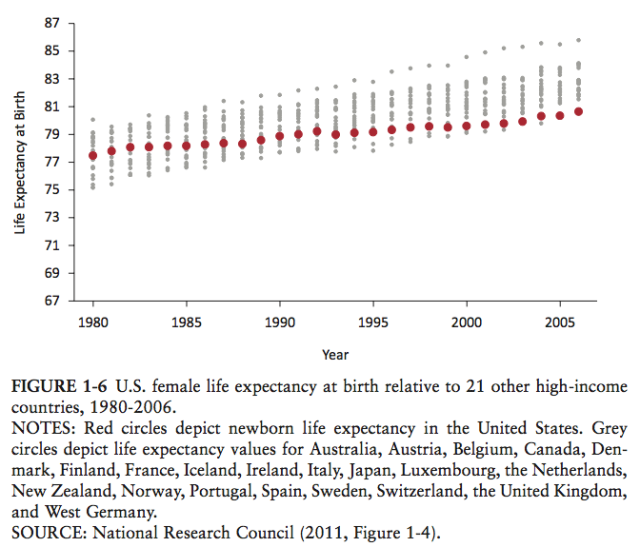
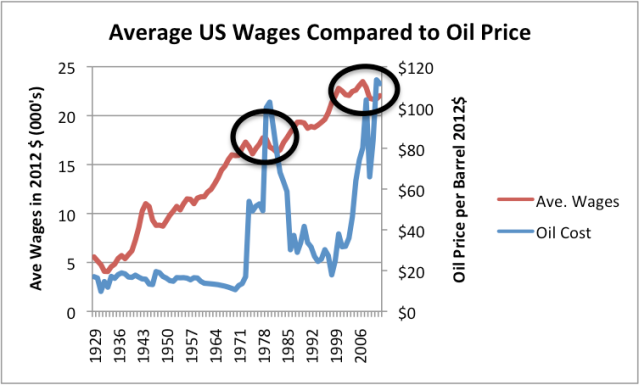
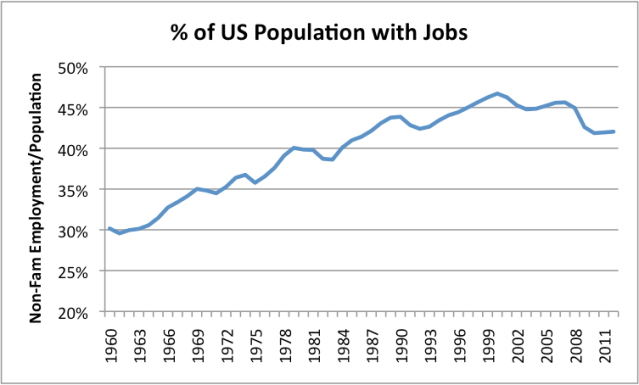

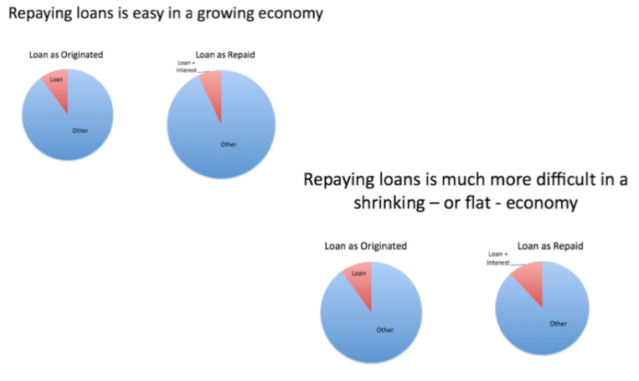
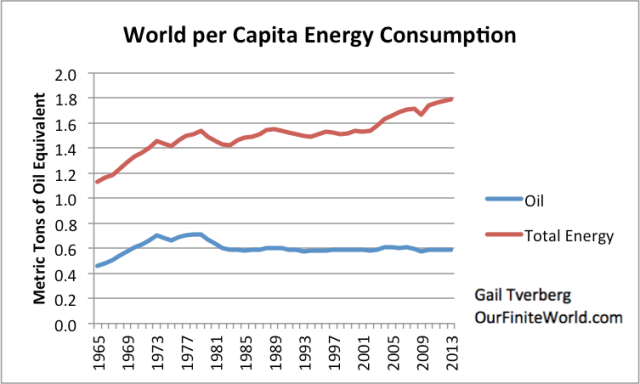
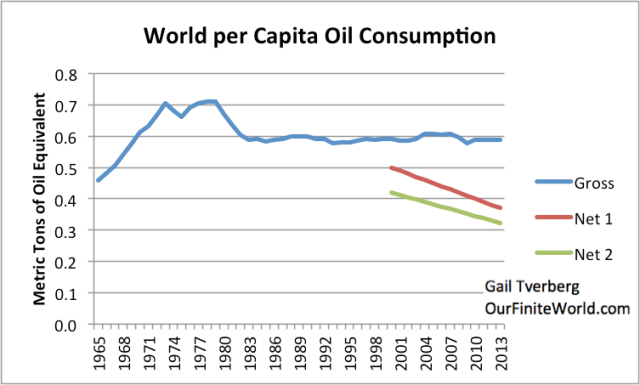

No comments:
Post a Comment
Note: only a member of this blog may post a comment.